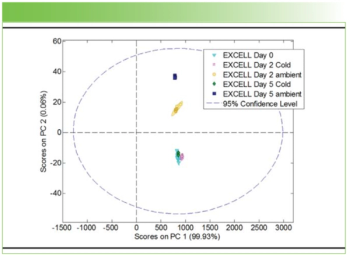
Glucose's Impact on Brain Cancer Cells Unveiled Through Raman Imaging
Researchers have used Raman spectroscopy and chemometric methods to reveal how glucose affects normal and cancerous brain cell metabolism. Their findings highlight specific biomarkers that can distinguish metabolic changes, potentially aiding in cancer research and treatment.
Glucose, a simple sugar, is essential for brain function and overall human physiology. A recent study by Monika Kopec, Karolina Beton-Mysur, Jakub Surmacki, and Halina Abramczyk from Lodz University of Technology in Poland has employed non-invasive Raman spectroscopy to explore how glucose impacts metabolic processes in normal and cancerous brain cells. This research, published in Scientific Reports, identifies critical biomarkers and offers insights into the metabolic variations caused by glucose supplementation (1).
Read More:
Exploring Glucose's Role in Brain Metabolism
The study focuses on human normal brain astrocytes (NHA) and two types of cancerous brain cells: astrocytoma (CRL-1718) and glioblastoma (U-87 MG). By using Raman imaging, the researchers could spectroscopically characterize these cell lines and observe metabolic changes upon glucose supplementation. The primary goal was to identify specific biomarkers within lipid droplets, mitochondria, and the nucleus that respond to glucose (1).
Key Findings
The research team identified distinct vibrational frequencies at 750 cm−1, 1444 cm−1, 1584 cm−1, and 1656 cm−1 that correspond to cytochromes, lipids, and proteins, which are crucial for differentiating between normal and cancerous cells. These biomarkers allow scientists to monitor how glucose influences the chemical composition of these cellular components (1).
Chemometric analysis, including partial least squares discriminant analysis (PLS-DA) and analysis of variance (ANOVA) tests, were used to confirm the differentiation of cell lines based on unique molecular properties. The study highlighted the significant roles of cytochromes, lipids, and proteins in distinguishing between control brain cells and those supplemented with glucose (1).
Raman Spectroscopy: A Non-Invasive Diagnostic Tool
Raman spectroscopy, combined with chemometric analysis, provided a non-invasive and precise method to study these metabolic changes. This technique allows for the detection of minute biochemical alterations within cells, offering a potential tool for monitoring disease progression and response to treatments (1).
Implications for Cancer Research
The study's findings suggest that glucose dramatically affects lipid droplets, mitochondrial activity, and the nucleus in both normal and cancerous brain cells. By understanding these changes, researchers can better comprehend how glucose contributes to brain cancer development and progression (1).
Glucose's role in cancer metabolism has been a significant area of interest, with studies linking high glucose levels to increased cancer cell proliferation and disease progression. This research adds to the body of knowledge by providing specific vibrational markers that can be used to monitor these changes (1). Note that a cancer cell, with its higher metabolic rate, demonstrates increased metabolism in the presence of glucose (2).
Conclusions
This comprehensive study offers valuable insights into the biochemical effects of glucose on brain cells. The researchers demonstrated that Raman spectroscopy, paired with chemometric methods, could effectively monitor the metabolic response to glucose in normal astrocytes, astrocytoma, and glioblastoma cell lines (1).
The identification of specific Raman biomarkers related to cytochromes, lipids, and proteins offers a new perspective on the metabolic regulation within brain cells. These findings could pave the way for developing novel diagnostic and therapeutic strategies targeting metabolic pathways influenced by glucose (1).
References
(1) Kopec, M., Beton-Mysur, K., Surmacki, J. et al. Metabolism Changes Caused by Glucose in Normal and Cancer Human Brain Cell Lines by Raman Imaging and Chemometric Methods. Sci Rep 2024, 14, 16626. DOI:
(2) Fadaka, A.; Ajiboye, B.; Ojo, O.; Adewale, O.; Olayide, I.; Emuowhochere, R. Biology of Glucose Metabolization in Cancer Cells. J Oncol Sci 2017, 3 (2), 45–51. DOI:
Newsletter
Get essential updates on the latest spectroscopy technologies, regulatory standards, and best practices—subscribe today to Spectroscopy.




